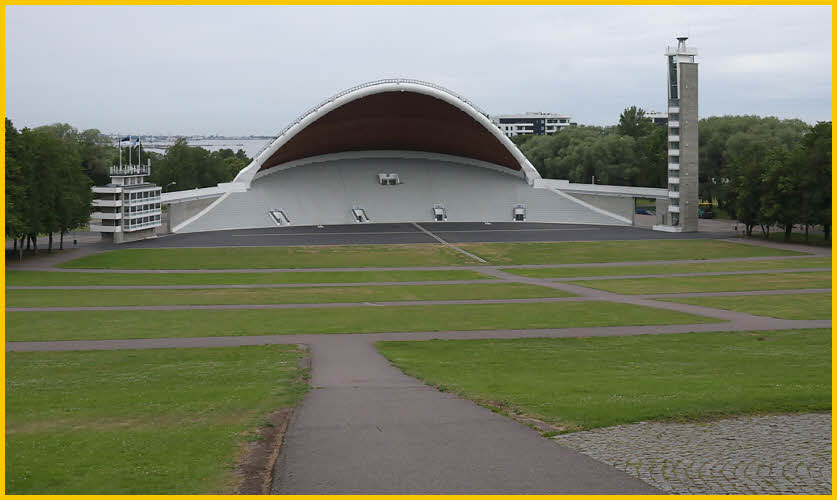Estonia
Song Festival Grounds
 |
In 1869 Johann Voldemar Jannsen established the Estonian Song Festival while the nation was still a province of the Russian Empire. This festival was considered responsible for fostering an Estonian national awakening. After that, the new tradition was born and the festivals are still held every five years.
he first stage on its current location between Narva Road and Pirita Road in Kadriorg, was built in 1928 for the 9th Estonian Song Festival. It was designed by Karl Burman and provided space for 15,000 performers.[1]
During the Occupation of Estonia by the Soviet Union, there was a need for a larger stage. The new and current arched stage was built in 1959 to celebrate the 20th anniversary of the Estonian SSR in the upcoming year. It was designed by architect Henno Sepmann together with Alar Kotli and Endel Paalmann. The 15th Estonian Song Festival in 1960 was celebrated on the new stage.[2] The stage was meant to hold over 15,000 singers but the reverse also became possible, with the performance taking place in front of the stage and audience sitting on the stage. On the northern side of the song stage is the 42m high fire tower, which is used during the Estonian Song Festivals. It is open for the public all year long.
In 1988, Estonians gathered at the Tallinn Song Festival Grounds, to sing patriotic hymns in what became known as the Singing Revolution that led to the overthrow of Soviet rule.
The Singing Revolution is a commonly used name for events between 1987 and 1991 that led to the restoration of the independence of Estonia, Latvia and Lithuania.[1][2] The term was coined by an Estonian activist and artist, Heinz Valk, in an article published a week after 10–11 June 1988, spontaneous mass evening singing demonstrations at the Tallinn Song Festival Grounds.
The "Five Patriotic Songs" series by Alo Mattiisen premiered at the Tartu Pop Festival in May 1988. In June the Old Town Festival was held in Tallinn, and after the official part of the festival, the participants moved to the Song Festival Grounds and started to sing patriotic songs together spontaneously. The Baltic Way, a human chain of two million people, spanned from Tallinn to Vilnius on 23 August 1989. Mattiisen's "Five Patriotic Songs" were performed again at the Rock Summer festival in Tallinn held on 26–28 August 1988. The Song of Estonia festival was held at the Song Festival Grounds on 11 September. Trivimi Velliste, Chairman of the Estonian Heritage Society, first voiced the public ambition to regain independence. The Supreme Soviet of Estonia issued the Estonian Sovereignty Declaration on 16 November.
The Singing Revolution lasted over four years, with various protests and acts of defiance. In 1991, as Soviet tanks attempted to stop the progress towards independence, the Supreme Soviet of Estonia together with the Congress of Estonia proclaimed the restoration of the independent state of Estonia and repudiated Soviet legislation. People acted as human shields to protect radio and TV stations from the Soviet tanks. Through these actions Estonia regained its independence without any bloodshed.
Independence was declared on the late evening of 20 August 1991, after an agreement between different political parties was reached. The next morning Soviet troops, according to Estonian TV, attempted to storm Tallinn TV Tower but were unsuccessful.
